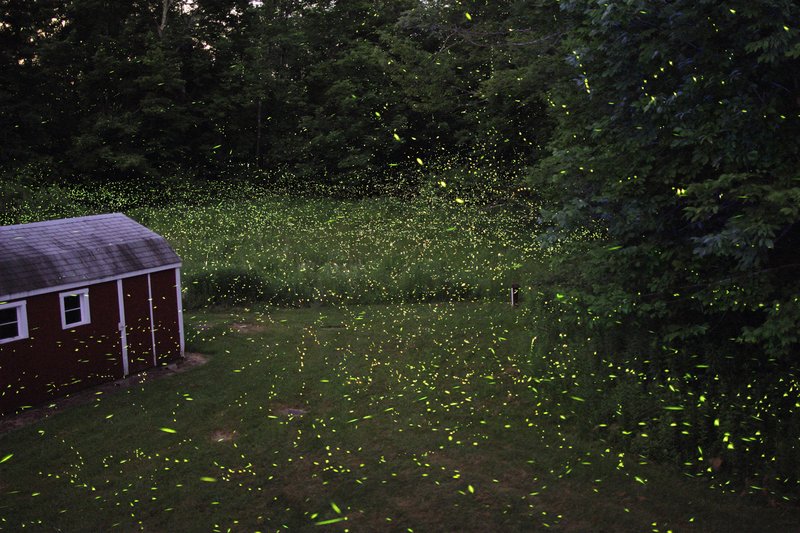It's Lightning Bug Season

( s58y / Flickr )
[music]
Brian Lehrer: Brian Lehrer on WNYC. Here we are in July and let's just say blueberries aren't the only thing in season. It's prime time to see the fireflies in action. Fireflies or lightning bugs, whatever you call those amazing creatures, make backyards and parks places of wonder, don't they, on midsummer evenings? The folks at Brooklyn Bridge Park say they're seeing quite the display on their Bridge View Lawn this year, a reward for some effort they've put in to making that urban park inviting to wildlife. We're joined now by Rebecca McMackin, the park's director of horticulture, and Pawel Pieluszynski, the wetland gardener there. Welcome to both of you. Welcome to WNYC.
Rebecca McMackin: Thanks so much for having us, Brian.
Pawel Pieluszynski: Hey, Brian.
Brian Lehrer: Listeners, if you have a question about fireflies or want to offer a field report on the best places to see them, and how many you're seeing in your neck of the woods, or if you want to do a Firefly call, or maybe they don't make calls, tweet @BrianLehrer or call us at WNYC at 212-433-WNYC, 212-433-9692. Rebecca, first, is there a difference between fireflies and lightning bugs, or are they the same insect that just ended up with two names?
Rebecca McMackin: They are the same insect. Actually, despite the name, they're beetles but they just have two different names like many things. For fireflies, they have the name of firefly on the West Coast, in the west of the United States, as well as in New England and the northeast. When you get into the south the southeast, that's where people call them lightning bugs.
Brian Lehrer: Pawel Pieluszynski, as the firefly expert, why are they giving us this show? I guess they have their own reasons having nothing to do with our love of twinkling lights, right?
Pawel Pieluszynski: Right. The fireflies we're familiar with, especially in New York City or the common eastern firefly, it's the male putting on a display to entice females to mate. The male will fly around and flash and the females just watch the show and hopefully track the male and they can mate and make more fireflies.
Rebecca McMackin: It's a wonderful display. That common eastern firefly is also called the Big Dipper Firefly. That's because the signal that it emits is this J shape. There are so many different species of firefly. The way that they tell who's flashing is by they each have a different signal that they send out. It's like a love song of light. They're not actually flashing for us, right? As Pawel said, they're flashing for female fireflies who are sitting on the ground or in the surrounding plants and they're watching the show.
The species, as Pawel said, it's the most common in North America, they each have a specific frequency of blinks. The Big Dipper does that J shape and it lasts for about half a second, and then it repeats every five seconds. If the females like it, they wait two seconds and then they flash back, which can, of course, lead to mating and egg, but it can also lead to an absolutely horrific end for the male firefly.
Brian Lehrer: Let's take a phone call. Here's Greg in Manalapan. Greg, you're on WNYC. Hello?
Greg: How are you doing, Brian? How are you doing today?
Brian Lehrer: Good.
Greg: I'm calling in because--
Brian Lehrer: What's you got for us on fireflies? Go ahead.
Greg: Oh, so there are fireflies all around my neighborhood, but there's a little lake down less than a mile from my house. Sorry, I had a root canal today, so my mouth is a little bit numb, but there's hundreds of fireflies down this path. Nobody knows about it. I've brought some friends to it, but it's like a light show. It's beautiful and I've never seen that many fireflies in one spot. Right around the lake, it's just one part of the lake that have them.
Brian Lehrer: Greg, thank you for the report. Pawel, what makes them concentrate like that in some places?
Pawel Pieluszynski: Actually, it's interesting because fireflies love moist environments and they're found around lakes and marshes because they lay their eggs in moist grounds. The larva or the baby fireflies, they go after prey that are found in those types of environments, so like slugs, snails, and earthworms. That's why you'll see them most concentrated around wet areas like the caller just mentioned.
Brian Lehrer: Maybe you were touching on this before, Rebecca, but the fireflies the way I think of them, the lighting seems random but I've read that some synchronize the flashing.
Rebecca McMackin: Yes. Species not in New York will synchronize. Each species has their own flash pattern, right? It's a colon response. In many places, you have multiple species of fireflies all flashing together. They need that methodology in order to communicate to the females and the males of their own species. Yes, some put on these absolutely beautiful displays of synchronous flashing but I do still think that our native fireflies put on a wonderful display as well.
Brian Lehrer: Suzanne in Hillsboro, you're on WNYC. Hi, Suzanne.
Suzanne: Hi, Brian. Thanks so much for your work. Watching the fireflies at dusk into the night is a wonderful bomb after the end of all the news and all.
Brian Lehrer: That's B-A-L-M, not the other kind. Just kidding.
Suzanne: Yes. [chuckles] My goodness. My question is they seem to start off flashing close to the ground and then rise slowly higher and higher until they're way up in the trees. Why is that?
Brian Lehrer: Pawel you know, or whoever wants to take it?
Pawel Pieluszynski: Rebecca, you could answer this.
Brian Lehrer: Go ahead, Rebecca.
Rebecca McMackin: Sure. Their flashing in their position is dependent upon many different factors. Temperature can change their flashing frequency. Then, of course, nighttime, right? The level of darkness. They're sending out light as their signal, they need to be in darkness. I've seen a bunch of fireflies flash against a canopy of trees because that's a backdrop that makes their signal the most apparent to the awaiting females. The light conditions can change.
Of course, at dusk, the light conditions can be one thing. Street lights can come on. Unfortunately, light pollution is one of the factors that can affect firefly populations, but they'll move in response to the darkness trying to find the best place for their display.
Pawel Pieluszynski: Also can I add something?
Brian Lehrer: Yes, go ahead.
Rebecca McMackin: Also, like the caller said, they start off maybe lower because during the day they're hiding in the vegetation. It's just a factor that they're waking up and then they start flying out more and more as twilight sets in.
Brian Lehrer: It was a little sad to read, Pawal, that this season summer is the sum total of their adult lifespan, a couple of weeks.
Pawel Pieluszynski: Right. A lot of insects have that life cycle. A lot of butterflies that you see are very short-lived. You could think about their life cycle as longer because they'll spend a year or maybe even two as larva. What we think as the firefly is just a short part of its life and they go out with a bang, so it's not too depressing.
Brian Lehrer: They stay in the larva stage longer. Do they glow as larvae?
Pawel Pieluszynski: Yes. Larvae are also called glow worms. Actually, one of the requirements for a firefly to be classified into that family is that the larva glow because there are a lot of insects that superficially resemble fireflies. One of the requirements, like I said, is for the glow worms to glow.
Brian Lehrer: Fireflies and lightning bugs you established before are the same thing. Also, glow worms.
Pawel Pieluszynski: Yes, There are also some fireflies that don't even flash, a vast majority actually.
Brian Lehrer: Even though they're called fireflies?
Pawel Pieluszynski: Yes.
Brian Lehrer: Sean in Maplewood, you're on WNYC. Hi, Sean.
Sean: Hi, Brian, I have a comment and a question. I walk my dog in the evenings here in Maplewood, New Jersey, which has been a very developed neighborhood, nothing new going on. I was walking my dog during the fireworks the other night. We weren't seeing any, but we were hearing them in the distance. There was just a field of fireflies and it occurred to me, what do you call a field of fireflies? Flyerworks.
[laughter]
Brian Lehrer: Oh, flyerworks.
Rebecca McMackin: Flyerworks.
Sean: Flyerworks, yes.
Brian Lehrer: You just called to make a bad joke. I'm just kidding. Go ahead.
[laughter]
Sean: No. I have a question, though, because this is the fifth year we've had our dog and I noticed that I have been seeing them in July every year, but very, very few compared to when I was a younger kid also growing up here decades ago. Over this year, they are way, way more than ever before. They're not in the one part of my walk where they've always been, but they're throughout the walk. What has happened in the last year that has caused more fireflies to be around?
Brian Lehrer: Interesting, Sean, hang on because I want to take another call that has an opposite observation in her neck of the woods. Christina in Tuxedo in Rockland. Christina, you're on WNYC. Hello.
Christina: Hey, Brian, how are you? I was just listening to this previous caller and piggyback what he said. When I was a child there were a gazillion fireflies all over the place. Every year I looked forward to the season, Ever since about 10 years, I have seen less and less and less fireflies. I'm wondering what is going on environmentally that's affecting them.
Brian Lehrer: Thank you very much. Are there more fireflies first of all or are there fewer fireflies in our region from year to year?
Rebecca McMackin: I think in general there's a decline going on with fireflies and with many groups of insects, sadly. You may have read about the insect apocalypse that we are currently in the midst of, and fireflies are absolutely part of that. The individual species could be doing fine.
Brian Lehrer: Honey bees, monarch butterflies, that's usually what we hear about in this insect apocalypse, right?
Rebecca McMackin: Absolutely, and so fireflies are absolutely part of that decline. However insects are very responsive to environmental conditions and you can have a really good year of like we had a great spring rain that could boost those populations, but in general, firefly populations are declining over all of the species. At Brooklyn Bridge Park though, we really consider it part of our mission to bring people and wildlife together for the benefit of everyone involved.
We do specific practices where we try and bring key species into the park, try to attract them like monarchs and Katydids, things that we think the public will really enjoy, or really important ecological species. Pawel does a lot of work actually to attract those fireflies to the park.
Brian Lehrer: Pawel, you want to talk about that a little more because it's obvious from its name that Brooklyn Bridge Park is part of an urban landscape even for people who don't know that wonderful spot, but you've been trying to make it function more like a wildlife area?
Pawel Pieluszynski: Oh, yes. Like Rebecca said, fireflies, in general, are experiencing declines in their populations. Brooklyn Bridge Park is an optimistic story. If you know anything about the history of the park, it was just all concrete here and now we have a lot of vegetation which is extensively native plants. I was here last week on the weekend and we have a great firefly population. We can encourage these things and bring them back even to urban areas where there was once concrete. We do a few key things. One is we're not as fastidious in cleaning leaves, we leave them on the ground. Fireflies really like that. They like those moist, wet environments and the shade. We leave the leaves there.
The listeners at home could do that. Maybe they have a back-of-house area near a rain spout they could leave their leaves. Also one of our key things is we don't use herbicides or pesticides or artificial fertilizers which has been shown to be decimating insect populations worldwide. As I mentioned, we grow native plants so it brings a diversity of habitat and structure, and brings those food species for fireflies, and also some adult fireflies actually nectar so they could be pollinators as well.
Also a big thing, and we have to work on this more but we are public park on lighting is key for safety, but also night pollution is very detrimental for these insects. Those listeners at home, if you're not using your outdoor lighting, turn it off, maybe have lights on a timer. Also, yellow LED bulbs are better than white or blue. First and foremost, habitat destruction is limiting biodiversity in general, so we should all be supportive of conservation efforts of wild places, especially in New York City.
Brian Lehrer: Last question, we have under a minute. Rebecca, is the park holding any firefly viewing events?
Rebecca McMackin: [laughs] Hopefully in the future. They don't really move that much so the fireflies like the wetlands on the Bridge View Lawn are likely going to return next year and this can be a regular viewing. We've absolutely talked about-- I work towards a world in which city folks can really connect to these natural phenomena and set up picnics to watch monarchs migrate through the city, and take a blanket to watch the fireflies. It is absolutely possible that we'll develop programming around these amazing natural events in the future.
Brian Lehrer: Rebecca McMackin, Brooklyn Bridge Park's director of horticulture, and Pawel Pieluszynski, the park's wetland gardener. Thank you both so much for a wonderful conversation.
Rebecca McMackin: It was our pleasure. Thanks so much, Brian.
Pawel Pieluszynski: Thanks, Brian.
Brian Lehrer: Brian Lehrer on WNYC. Have a great weekend, everyone.
Copyright © 2022 New York Public Radio. All rights reserved. Visit our website terms of use at www.wnyc.org for further information.
New York Public Radio transcripts are created on a rush deadline, often by contractors. This text may not be in its final form and may be updated or revised in the future. Accuracy and availability may vary. The authoritative record of New York Public Radio’s programming is the audio record.

